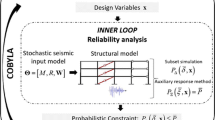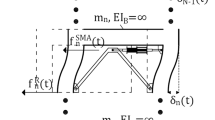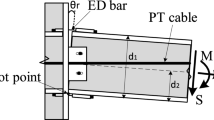Abstract
A new optimal control approach is presented for designing and controlling inelastic lateral load resisting systems. This paper uses the technique to develop a seismic retrofit procedure for inelastic shear-type resisting systems with stiffness changes and nonlinear fluid viscous dampers (FVDs). Generally, optimal control procedures aim to derive the optimal constant output feedback gains based on the weighting components assigned to the system's regulated outputs, which define their relative importance during the cost function minimization process. However, stiffness changes and FVD coefficients (the constant output feedback gains) are initially assigned in the reversed optimal control approach. Then, the consequent weighting matrices are calculated assuming the system is at its optimal state. Finally, a recurrence relation for updating the stiffness changes and added damping quantities is proposed based on the relative size between the weighting matrix components. While this paper addresses inelastic shear-type resisting systems, the reversed optimal control approach is suitable to other dynamic systems whose state vector trajectory can be determined. Two case studies examine and exemplify the developed procedure. The first case study analyzes a spectrum of single-degree-of-freedom (SDOF) systems and investigates the correlation between the weighting components and system configurations. The second case study applies the developed procedure to a five-story shear-type resisting system and demonstrates its reliability in sequentially minimizing the cost function while reducing relative interstory drifts and absorbed yield energy.
















Similar content being viewed by others
References
Agrawal AK, Yang JN (1999) Design of passive energy dissipation systems based on LQR control methods. J Intell Mater Syst Struct 10:933–944. https://doi.org/10.1106/FB58-N1DG-ECJT-B8H4
Cimellaro GP, Soong TT, Reinhorn AM (2009) Integrated design of inelastic controlled structural systems. Struct Control Health Monit 16:689–702. https://doi.org/10.1002/stc.314
Ferreira FLS, Simoes LMC (2011) Optimum design of a controlled cable stayed bridge subject to earthquakes. Struct Multidiscip Optim 44:517–528
Gluck N, Reinhorn AM, Gluck J, Levy R (1996) Design of supplemental dampers for control of structures. J Struct Eng 122:1394–1399. https://doi.org/10.1061/(asce)0733-9445(1996)122:12(1394)
Loh CH, Lin PY, Chung NH (2000) Design of dampers for structures based on optimal control theory. Earthq Eng Struct Dyn 29:1307–1323. https://doi.org/10.1002/1096-9845(200009)29:9%3c1307::AID-EQE972%3e3.0.CO;2-D
Peng YB, Ghanem R, Li J (2013) Generalized optimal control policy for stochastic optimal control of structures. Struct Control Health Monit 20:187–209. https://doi.org/10.1002/stc.483
Shmerling A, Levy R, Reinhorn AM (2018) Seismic retrofit of frame structures using passive systems based on optimal control. Struct Control Health Monit 25:e2038. https://doi.org/10.1002/stc.2038
Yamada K, Kobori T (1996) Linear quadratic regulator for structure under on-line predicted future seismic excitation. Earthq Eng Struct Dyn 25:631–644. https://doi.org/10.1002/(SICI)1096-9845(199606)25:6%3c631::AID-EQE574%3e3.0.CO;2-K
Dertimanis VK, Chatzi EN (2018) LQR-UKF active comfort control of passenger vehicles with uncertain dynamics. IFAC-PapersOnLine 51:120–125. https://doi.org/10.1016/j.ifacol.2018.09.101
Miyamoto K, Sato D, She J (2018) A new performance index of LQR for combination of passive base isolation and active structural control. Eng Struct 157:280–299. https://doi.org/10.1016/j.engstruct.2017.11.070
Cheung YL, Wong WO, Cheng L (2013) Optimization of a hybrid vibration absorber for vibration control of structures under random force excitation. J Sound Vib 332:494–509. https://doi.org/10.1016/j.jsv.2012.09.014
Petersson D, Löfberg J (2014) Model reduction using a frequency-limited H2-cost. Syst Control Lett 67:32–39. https://doi.org/10.1016/j.sysconle.2014.02.004
Takewaki I (2000) Optimal damper placement for planar building frames using transfer functions. Struct Multidiscip Optim 20:280–287
Yang JN, Lin S, Jabbari F (2004) H∞-based control strategies for civil engineering structures. Struct Control Health Monit 11:223–237. https://doi.org/10.1002/stc.38
Sun H, Zuo L, Wang X et al (2019) Exact H 2 optimal solutions to inerter-based isolation systems for building structures. Struct Control Health Monit 26:e2357. https://doi.org/10.1002/stc.2357
Bai Y, Grigoriadis KM (2009) Damping parameter design optimization in structural systems using an explicit H∞ norm bound. J Sound Vib 319:795–806
Lin C-C, Chang C-C, Chen H-L (2006) Optimal H∞ output feedback control systems with time delay. J Eng Mech 132:1096–1105. https://doi.org/10.1061/(asce)0733-9399(2006)132:10(1096)
Shmerling A, Levy R (2018) Seismic upgrade of structures using the H∞ control problem for a general system interconnection paradigm. Struct Control Health Monit 25:e2162. https://doi.org/10.1002/stc.2162
Shmerling A, Levy R (2019) Seismic structural design methodology for inelastic shear buildings that regulates floor accelerations. Eng Struct 187:428–443. https://doi.org/10.1016/j.engstruct.2019.02.062
Apkarian P, Noll D (2006) Nonsmooth H∞ synthesis. IEEE Trans Autom Control 51:71–86
Du H, Zhang N, Nguyen H (2008) Mixed H2/H∞ control of tall buildings with reduced-order modelling technique. Struct Control Health Monit 15:64–89. https://doi.org/10.1002/stc.207
Khot NS, Öz H (1997) Structral–control optimization with H2-and H∞-norm bounds. Optim Control Appl Methods 18:297–311
Lei JS, Chen M, Zou YS (2007) Optimal design of energy dissipation systems added viscoelastic dampers based on H∞ and H2 performances. Hunan Daxue Xuebao J Hunan Univ Nat Sci 34:921–936
Lu J, Skelton RE (2000) Integrating structure and control design to achieve mixed H2/H performance. Int J Control 73:1449–1462. https://doi.org/10.1080/00207170050163323
Palazzo B, Petti L (1999) Optimal structural control in the frequency domain: control in norm H2 and H∞. J Struct Control 6:205–221. https://doi.org/10.1002/stc.4300060202
Xiang P, Nishitani A (2015) Optimum design of tuned mass damper floor system integrated into bending-shear type building based on H∞, H2, and stability maximization criteria. Struct Control Health Monit 22:919–938. https://doi.org/10.1002/stc.1725
Mazza F (2019) A simplified retrofitting method based on seismic damage of a SDOF system equivalent to a damped braced building. Eng Struct 200:109712. https://doi.org/10.1016/j.engstruct.2019.109712
Terenzi G, Costoli I, Sorace S (2020) Activation control extension of a design method of fluid viscous dissipative bracing systems. Bull Earthq Eng 18:4017–4038. https://doi.org/10.1007/s10518-020-00849-5
Mulay N, Shmerling A (2021) Analytical approach for the design and optimal allocation of shape memory alloy dampers in three-dimensional nonlinear structures. Comput Struct 249:106518. https://doi.org/10.1016/j.compstruc.2021.106518
Reinhorn AM, Lavan O, Cimellaro GP (2009) Design of controlled elastic and inelastic structures. Earthq Eng Eng Vib 8:469–479. https://doi.org/10.1007/s11803-009-9126-0
Grimble MJ, Biss D (1988) Selection of optimal control weighting functions to achieve good H-infinity robust designs. In: International conference on control, 1988. CONTROL 88. IET, pp 683–688
Kneppova V, Kiffmeier U, Unbehauen H (1995) Weighting function selection in H∞-optimal control with application to a thyristor-driven DC-motor. In: Proceedings of the American control conference. IEEE, pp 3002–3006
Luo J, Lan CE (1995) Determination of weighting matrices of a linear quadratic regulator. J Guid Control Dyn 18:1462–1463. https://doi.org/10.2514/3.21569
Miyamoto K, She J, Sato D, Yasuo N (2018) Automatic determination of LQR weighting matrices for active structural control. Eng Struct 174:308–321. https://doi.org/10.1016/j.engstruct.2018.07.009
Moghaddasie B, Jalaeefar A (2019) Optimization of LQR method for the active control of seismically excited structures. Smart Struct Syst 23:243–261. https://doi.org/10.12989/sss.2019.23.3.243
Sato D, Chen Y, Miyamoto K, She J (2019) A spectrum for estimating the maximum control force for passive-base-isolated buildings with LQR control. Eng Struct 199:109600. https://doi.org/10.1016/j.engstruct.2019.109600
Levy R, Lavan O (2006) Fully stressed seismic design of dampers in framed structures. Solid Mech Appl 140:303–315. https://doi.org/10.1007/1-4020-4891-2_25
Diotallevi PP, Landi L, Dellavalle A (2012) A methodology for the direct assessment of the damping ratio of structures equipped with nonlinear viscous dampers. J Earthq Eng 16:350–373. https://doi.org/10.1080/13632469.2011.618521
Author information
Authors and Affiliations
Corresponding author
Ethics declarations
Conflict of interest
The author declares that there is no conflict of interest regarding the publication of this paper.
Rights and permissions
About this article
Cite this article
Shmerling, A. Reversed optimal control approach for seismic retrofitting of inelastic lateral load resisting systems. Int. J. Dynam. Control 10, 2034–2052 (2022). https://doi.org/10.1007/s40435-022-00939-z
Received:
Revised:
Accepted:
Published:
Issue Date:
DOI: https://doi.org/10.1007/s40435-022-00939-z




